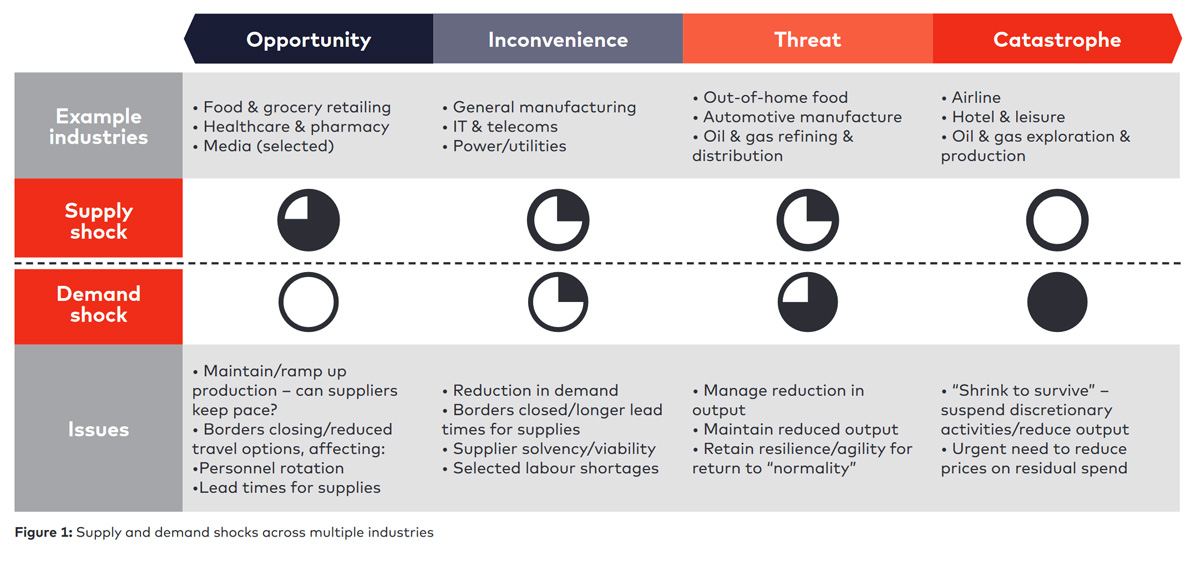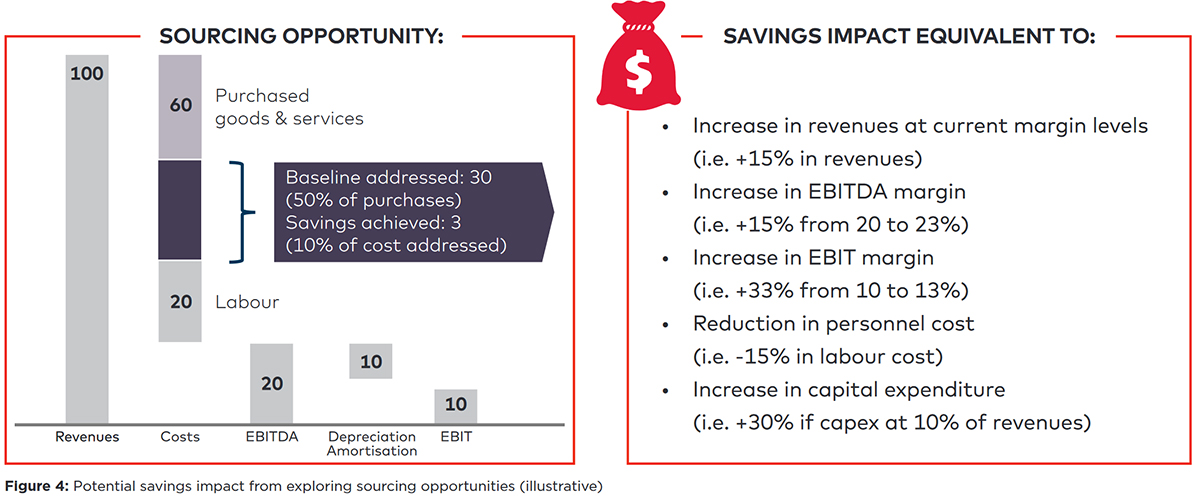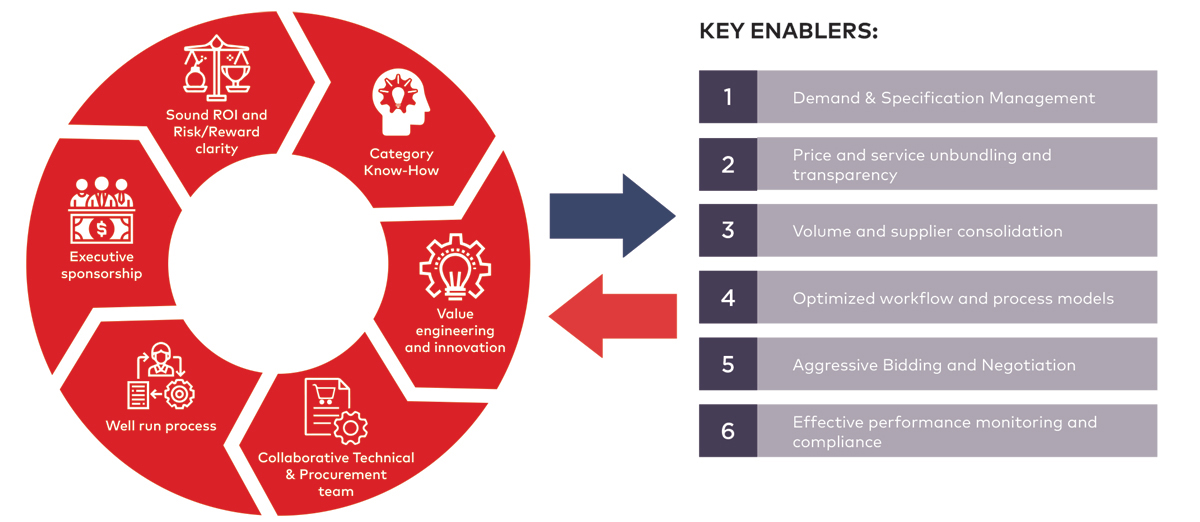Strategic Sourcing - A Lever to Address Supply Chain Disruptions and Create Significant Value
Organisations across the world are grappling with the impact of COVID-19, which has not only disrupted global supply chains, but also tested the effectiveness of existing business continuity plans. For many companies, weaknesses in planning manifested into painful losses. Since the initial days of the pandemic, most organizations have adjusted their budgets and developed recession contingency plans. However, as this crisis continues, companies must move to the next step: realigning the way they operate to sustainably navigate instability.
This new economic reality requires flexibility and companies showing the highest level of agility in adapting fast to new demand patterns will win. Strategic sourcing is a lever companies should focus on to reduce cost, sustain operations, and thrive as a successful business in the future.

Current supply/demand disruptions create a need for an alternative sourcing approach With most parts of the world in varying degrees of lockdown and the movement of goods and people remaining limited, the operating models of most companies have experienced extreme strain. Shocks to supply and demand due to COVID-19 have threatened business continuity, introduced new risks, and added new inefficiencies to operations.
Such shocks have been observed across multiple industries with extremely different supply chains. Indeed, healthcare, pharmaceuticals, and some food & beverage companies have seen an opportunity for growth with high demand, but face challenges of in-time availability of raw materials. On the other end of the spectrum, airlines and oil & gas companies are suffering from low demand for their goods & services and are embarking on rigorous cost optimisation exercises.
Figure 1 illustrates the varying levels of supply and demand shocks across multiple industries and the current reality enforced on them as a result of that. COVID-19 has exposed the unreliable sourcing strategies of many organisations.

The situation has highlighted several factors that should be considered before contracts are put in place, including:
- Local vs. global vendor: Heavy reliance on low-cost countries like China hasn't helped many global players. A diverse sourcing approach is required to manage supply risks.
- Terms and conditions: Sharing the pain by dealing with disruptions together as strategic partners should benefit all parties rather than contribute to collapse.
- Alignment with business continuity plans: Planning for and storage of emergency stock to ensure business continuity.
- Transparency: The visibility of supply network risks and capacity constraints should be clear.
Sourcing is a fundamental aspect of a resilient and mature purchasing organisation
The ability of an organisation to respond effectively to external supply/demand disruptions depends heavily on its internal procurement value chain.
There are two fundamental pieces of the procurement value chain that represent the starting point of a strong setup: Analysis and Sourcing (Figure 3). It is essential to have a structured, analytical approach to scope identification, spend analytics, supplier and business risk management, and supplier review and selection. Sourcing lays the foundations for effective category and vendor strategies and improved long-term value and contract performance.

Even though the first procurement function was established in the 1800s and has evolved through several rounds of transformations, organisations continue to face basic sourcing challenges that under-leverage the ability to purchase departments to contribute to an organisation's competitiveness:
- Analysis: Incorrect understanding of demand and specification needs as well as spending patterns, often resulting in a restricted vendor ecosystem, characterised by higher than necessary costs and bloated working capital.
- Sourcing Strategy: Single source situation with no backup, no prequalified product alternatives for key purchases. If the purchasing organisation is not reactive, the organisation will find it hard to quickly address supply issues and negotiate solutions with vendors.
- Procurement Process: If process compliance is low, it will lead to high off-contract spending and ineffective demand management measures.
- Contract Management: If contracts don't include the right triggers e.g. for raw materials, organisations won't be able to adapt price or volume. If the warehouse management system is not transparent enough organisations won't be able to make the right arbitrage between reducing their stock levels and business continuity risks.
A mature sourcing and procurement organisation is more than ever a key success factor in responding rapidly and effectively to disruptions, like COVID, to manage risks and protect value.
Effective sourcing practices can create significant value
Effective sourcing of goods and services represents one of the largest cost-saving opportunities, with a rapid measurable impact on organisations. It is a highly effective tool that reaps benefits over a reasonably short period of time with a comparably low pain level, while also balancing risk-return tradeoffs and targeting wider improvements such as:
- reduction of operational risks,
- improved operational efficiency,
- minimised supply chain risks and
- business continuity and sustainability.
Figure 4 provides an illustrative example of the value of a successful sourcing intervention. Based on a typical manufacturing environment where purchased goods and services represent 60% of revenues, the impact of a sourcing initiative is equivalent to a 15% reduction in workforce or a 15% increase in revenue. Sourcing is one of the quick win value levers and represents an attractive area for optimisation during a period like the COVID-19 crisis.

Companies can target both strategic and rapid sourcing as levers for cost reduction. Strategic sourcing targets high spend / high-risk categories, and its impact on the organisation is of higher significance. Strategic sourcing is a highly bespoke, category-specific approach that guarantees a high impact on cost and supply chain risk while at the same time providing an opportunity to upskill the existing purchasing organisation.
Six guiding principles to enable Sourcing success
In order to achieve success during a sourcing initiative, companies need to adopt a resilient approach with a well-defined set of guiding principles that can maximise the output from such initiatives.

- Category Know-How: There are often core purchasing and raw material categories where each organisation has a longstanding intricate knowledge, and then there are areas where contribution to domain knowledge is required. This can be in the form of a vendor list of several hundred suppliers of chemicals products, rate cards for specific products & services, or RFX templates and bid grids.
- Value Engineering and Innovation: Working within the existing specification is often only the second-best solution. So, while casting the net wide, it is essential to include and test product alternatives and consider innovation. Question the current standards and find ‘different ways of working’ to improve operational efficiency, including the use of the new digital tools.
- Collaborative Technical and Procurement Team: To effectively innovate and challenge specifications, purchasing needs to be on an equal footing with the technical teams throughout the organisation. Constructive discussions and inter-team dialogues should take place to ensure that evolution in specifications is not only driven by technical or production considerations but also supply chain implications.
- Well-Run Process: A sourcing process involves several internal departments including, R&D, technical, production, logistics, marketing, and numerous vendors. Accordingly strong project management is key to achieving timely results.
- Executive Sponsorship: Sourcing often leads to opportunities, but also to risk/return tradeoffs. Executives' sponsorship, clear accountability, and decision-making are preconditions to harvest and lock in the potential improvement.
- Sound ROI and Risk/Reward clarity: Companies need to define the right scope and sequencing of the initiative upfront to keep the resourcing in line with the opportunity and ensure a healthy return on investment.
Conclusion
Within the current economic context, strategic sourcing represents a great opportunity and lever for organisations to achieve their cost-saving objectives, address sustainability factors along the supply chain and maintain the balance of trade-offs between their strategic objectives. dss+ - through its focus on risk, a robust approach, and past experience - supports strategic sourcing initiatives by working closely with client teams to rapidly define and implement their sourcing objectives, and to sustain this value through improved management systems and effective upskilling of organisations. Such efforts can not only help companies to navigate the current challenges presented by the pandemic, but also maximise flexibility and agility in a post-COVID world.